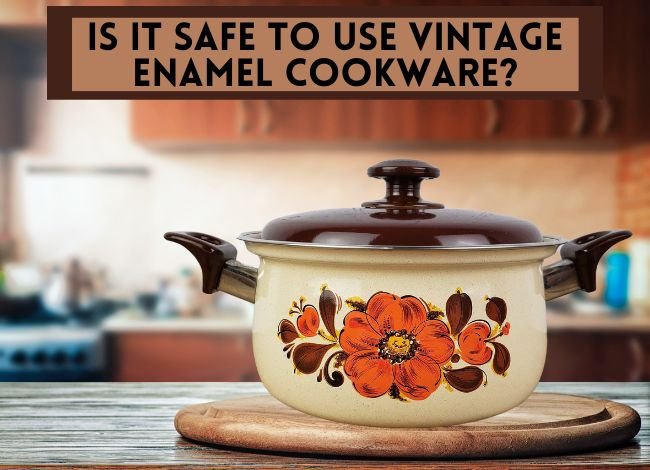Enamel cookware has been in use for decades. Its beautiful glossy finish and myriad colors have made it popular in many kitchens worldwide. But with the increasing awareness about cookware materials and their implications on health, many people have questions about the safety of using vintage enamel cookware. Let’s explore these concerns and shed some light on this topic.
Is it safe to use vintage enamel cookware? Let’s see it in detail.
Similar Articles: Is Rachael Ray Cookware Safe?
When used in this way, is enamel cookware harmful?
Enamel cookware, at its core, consists of metal, often iron or steel, coated with a thin layer of enamel – a melted and fused glass. This enamel layer prevents the metal underneath from contacting food when in good condition. Therefore, as long as the enamel coating is intact, there’s no direct risk of metal leaching into your food.
However, vintage enamel cookware can have chips or cracks in the enamel. When that happens, the underlying metal becomes exposed, and there’s potential for it to react with acidic foods, which can lead to metal leaching. If the underlying metal is cast iron, this isn’t a significant health concern, but if it’s aluminum or a less familiar metal, one should be cautious.
Are enamel frying pans a good choice?
Enamel frying pans can be a good choice, primarily for their non-reactive qualities. They don’t impart flavors or leach materials into food when the enamel is in good condition. However, they might not be the best for high-heat searing or frying since they don’t conduct heat as efficiently as bare metal pans.
Also, what is the best way to clean old enamel?
For vintage enamel cookware, gentle cleaning is key:
- Use warm soapy water and a soft cloth or sponge.
- Avoid abrasive scrubbers like steel wool which can damage the enamel.
- For stubborn stains, a mixture of baking soda and water can gently scrub the surface.
What is the least harmful cookware you can recommend?
The least harmful cookware options are Cast iron, stainless steel, and high-quality ceramic. They are durable and don’t leach harmful substances into food when used and maintained correctly.
When it comes to cooking, what is the healthiest cookware to use?
The healthiest options are those that don’t leach chemicals or metals into food. Cast iron, stainless steel, ceramic, and glass are considered among the healthiest.
Is it harmful to cook using aluminum cookware?
There has been some concern over aluminum leaching into food, especially acidic food. However, most modern aluminum cookware is anodized, which makes it non-reactive. Still, if you’re concerned, avoiding or minimizing cooking with plain aluminum pots and pans is best.
What is the most environmentally friendly material for pots and pans?
Cast iron is highly durable, can last for generations, and doesn’t require the chemical processes associated with non-stick coatings, making it environmentally friendly. Stainless steel is recyclable, making it another green choice.
Is stainless steel a health hazard?
Stainless steel is generally considered safe for cooking. It’s non-reactive, so it won’t leach substances into your food. However, ensure that it’s high-quality stainless steel without any coatings.
Is it safe to cook using Magnalite cookware?
Magnalite is an aluminum alloy. While the concerns about aluminum apply here, many Magnalite products have a hard-anodized surface, which reduces reactivity. If you have vintage Magnalite without this treatment, be cautious with acidic foods.
Is stainless steel cookware a non-toxic material to use?
Yes, stainless steel is non-toxic and preferred for many kitchen tools and appliances.
When is it OK to toss out nonstick pans?
Nonstick pans should be tossed when the coating peels, flakes, or chips. Damaged coatings can lead to the ingestion of non-stick material, which isn’t healthy.
Is it okay to boil milk in stainless steel?
Yes, it’s perfectly safe to boil milk in stainless steel pots. Stainless steel is non-reactive, durable, and doesn’t leach substances into the milk. However, it’s essential to stir the milk regularly while boiling to prevent sticking or scorching at the bottom of the pot.
When it comes to enamelware and Graniteware, what is the difference?
Both are types of coated metal cookware, but they have different coatings. Enamelware is coated with enamel, a type of glass. Graniteware (or speckleware) is coated with a porcelain enamel that is often speckled.
What is the composition of enamelware?
Enamelware primarily comprises a metal base, often iron or steel, coated with a thin enamel layer. This enamel is a type of fused glass that is melted and adhered to the metal surface at high temperatures, providing a non-reactive, durable, and often colorful finish to the cookware.
What is enamel coating, and how does it work?
The enamel coating is a smooth, glassy coating fused to metal at high temperatures. It provides a non-reactive and often colorful surface, protecting the metal beneath and preventing reactions with food.
What is the best way to cook using enamelware?
When cooking with enamelware, it’s best to use low to medium heat, ensuring even heat distribution and preventing damage to the enamel surface. Avoid sudden temperature changes, which can cause the enamel to crack or chip. Additionally, always use wooden or silicone utensils to protect the enamel from scratching or chipping.
How do you clean enamel cookware that has become discolored?
Make a paste of baking soda and water to clean discolored enamel cookware. Gently apply this mixture to the stained area using a soft cloth or sponge, rubbing in a circular motion. Rinse thoroughly with warm water and dry. This method helps lift discolorations without scratching the enamel surface.
Final thoughts: Is it safe to use vintage enamel cookware?
While aesthetically pleasing, vintage enamel cookware can pose risks if the enamel is chipped or cracked, exposing the underlying metal. When intact, the enamel is non-reactive and safe. However, if damaged, the exposed metal might react with certain foods. It’s essential to inspect and ensure the coating’s integrity before use.




